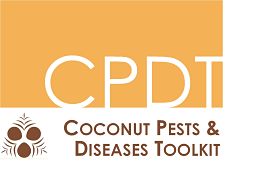Post-border biosecurity
Most importantly, the International Guidelines for transfer of coconut germplasm should be strictly followed to prevent pests and diseases being moved to new locations.
in this sub-section: International post-border biosecurity : Domestic post-border biosecurity : Information sources and further reading
International post-border biosecurity
International biosecurity focuses on early detection and rapid response to any incursion of pests or diseases. International post-border biosecurity focuses on surveillance, incursion response, and movement controls of known pests and diseases.
Surveillance
Surveillance programmes facilitate early detection of invasive ant species, allowing response to be rapid. In addition, regular surveillance assures trade partners that exports are safe. The information gathered also contributes to our wider knowledge of rates of spread of pest species.
Surveillance of high risk sites is the best form of post-border defence against incursions of pests and diseases. High risk areas for entry of pests and diseases include seaports, airports, devanning sites, sea container storage sites and transitional facilities.
If an unwanted pest or disease does invade, movement controls will ensure that it doesn't spread, particularly to high value sites.
Two broad approaches to surveillance are:
- Active surveillance: Where surveys are undertaken using a number of techniques including visual surveys, traps and attractive lures
- Passive surveillance: involves building public awareness of emerging biosecurity risks and acting on any sightings of target organisms that are reported
Surveillance can require a lot of resources, particularly time, but these costs are only a tiny fraction of what would need to be spent to control an established pest or of the economic and social costs invasive species can impose.
The MPI Surveillance Guide is an excellent resource that explains the various stages of planning surveillance with examples.
Incursion response
Incursion response requires a strategy, a plan, and ensuring all the components of that plan are in place before any possible incursion. A plan alone is not enough. The New Zealand Coordinated Incident Management System (CIMS) 2nd Edition and indicates the structure and content of an effective response plan.
When preparing a response plan it is useful to refer to plans produced elsewhere, such as this draft rapid response plan for red imported fire ant in Hawaii. The Lake Champlain Basin rapid response action plan for aquatic invasive species provides an excellent example of the various stages of a rapid response.
A rapid response is not cheap and resources must be allocated ahead of time, and so assessing risk is an important aspect.
Movement controls
Movement controls are used to contain an incursion and prevent pests and diseases spreading from an infested area.
There are two parts to the containment:
- Reduction of natural spread: pests or diseases that have spread to a new area independently (by flight or on foot) from spreading to new areas by removing potential habitat sites and buffer clearance. Ensure the area surrounding the infestation (buffer zone) is free from potential habitat.
- Reducing the risk of jump dispersal - ensuring pests and diseases are unable to " hitchhike" out of the infested area and establish elsewhere. The greater risk is via jump-dispersal associated with human transport. The first step required for reducing the risk of jump-dispersal is the identification of the high-risk pathways out of infested areas. Any goods, vehicles or machinery that could harbour pests or diseases that are moved from the infested area represent potential pathways for the spread.
Both parts involve surveillance. In particular high value areas should be identified and secured.
Domestic post-border biosecurity
As well as being a major component of international biosecurity, post-border actions are also important for domestic biosecurity. Domestic border security should also focus on surveillance, incursion response, and movement controls of known pests and diseases.
In Pacific nations, which are often made up of a number of atolls and islands with close transport links, the risk of transporting invasive species within country is high. All the activities undertaken for pre-border and at-border biosecurity can be applied to domestic situations.
As movement controls are difficult to enforce in a domestic situation, and domestic biosecurity legislation is typically non-existent, community awareness is critical to generating support for domestic biosecurity.
Information sources and further reading
You can find a comprehensive guide to prevention in the Pacific Invasive Ant Toolkit (PIAT). Although the PIAT focuses on ants, the general principles (Pre-export and Pre-, At-, and Post-border protection) are the same for all pest and disease threats.
COGENT. 2018. Darwin Initiative "Upgrading and broadening the new South-Pacific International Coconut Genebank". [ONLINE]
EPPO. 2018. EPPO Global Database. [ONLINE]
Faleiro et al. 2016. Integrated Pest Management (IPM) of Palm Pests. Integrated Pest Management in the Tropics, pp. 439-497
FAO. 2018. Adopted Standards (ISPMs). [ONLINE]
Frison, Putter, Diekmann. 1993. FAO/IBPGR Technical Guidelines for the Safe Movement of Coconut Germplasm. FAO and IBPGR, p.1-48.
World Trade Organisation. 1998. Agreement on the Application of Sanitary and Phytosanitary Measures ("SPS Agreement"). [ONLINE]
